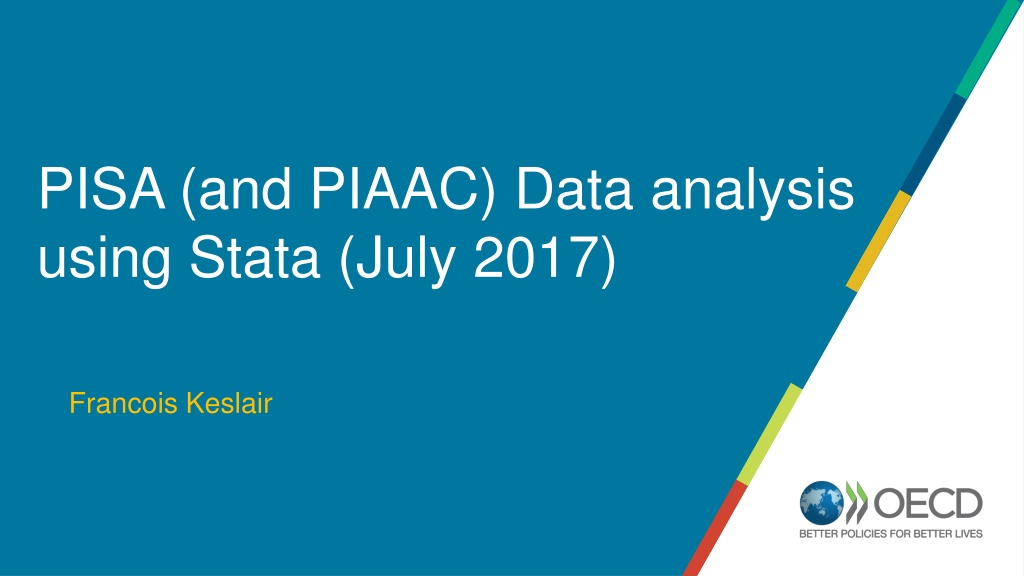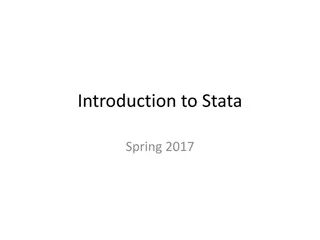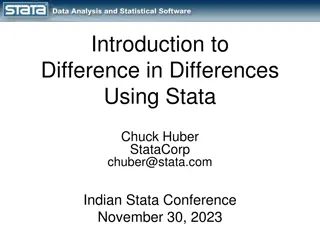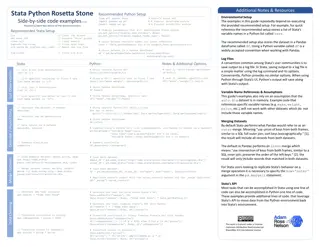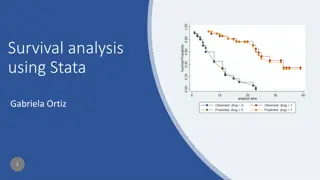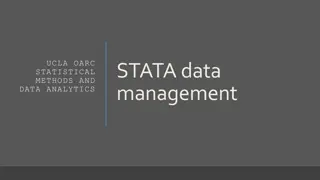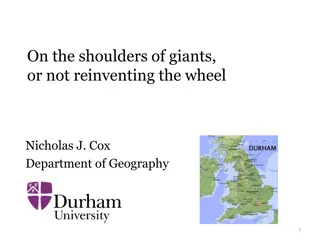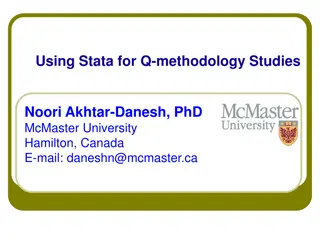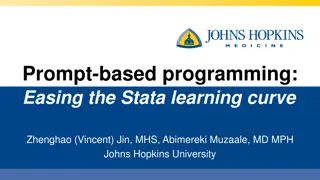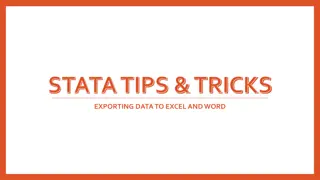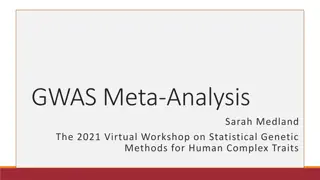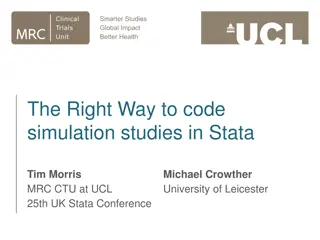Utilizing Replicate Estimate (Repest) for PISA and PIAAC Data Analysis in Stata
Explore how to use the Stata routine Repest for complex survey designs, accommodating final weights, replicate weights, and imputed variables in PISA and PIAAC data analysis. Learn to install and apply Repest to compute means of variables while accounting for sampling variance, clustering, and stratification, ultimately enhancing the accuracy of estimations.
Download Presentation

Please find below an Image/Link to download the presentation.
The content on the website is provided AS IS for your information and personal use only. It may not be sold, licensed, or shared on other websites without obtaining consent from the author. Download presentation by click this link. If you encounter any issues during the download, it is possible that the publisher has removed the file from their server.
E N D
Presentation Transcript
PISA (and PIAAC) Data analysis using Stata (July 2017) Name of Speaker Francois Keslair
Repest is a Stata routine (ado file), freely available at IDEAS, that: 1. Is specially designed for complex survey designs: Accommodates final weights and uses replicate weights for the sampling variance; Allows analysis with multiply imputed variables: Accepts plausible values and incorporates imputation variance in the computation of total variance. 2. By Francesco Avvisati and Francois Keslair (OECD)
How to install repest From the Stata command window (version 11.0 and above), type ssc install repest, replace
Origins 1. One generic tool for all OECD skills surveys is better surveys than several specific ones. 2. Making life easier for internal and external users Program core principle: Repest run any eclass command inside loops over plausible values and/or replicated weights
Table I.6.2A Use repest to compute simple means of variables repest PISA,estimate(means escs) by(cnt) estimates correct sampling variance (accounting for clustering + stratification)
Figure I.1.1 Use repest to compute simple means of performance variables repest PIAAC,est(means pvlit@) by(cntry_e) Combines sampling and imputation variance in estimation of S.E.
Survey design entails two kinds of weights: PISA FINAL STUDENT WEIGHTS Students and schools in a particular country did not necessarily have the same probability of selection; Differential participation rates according to certain types of school or student characteristics are required; Some explicit strata were over- sampled for national reporting purposes; Various non-response adjustments. REPLICATE WEIGHTS (BRR) Replicate weights are used to refine the calculation of standard errors in complex sampling designs: There are many possible samples of schools and they do not necessarily yield the same estimates; Each replicate weight represents one sample; They take into account the error of selecting one school and not another (sampling error). PISA gives a representative sample of 15 yo pupils
Why repest and not svyset , vce(brr) Multiply imputed variables
Plausible values serve two basic functions: To account for the lack of precision (measurement error) of the instrument (i.e. the test items) used to measure the performance of the target population; To provide a set of plausible scores for every student, overcoming the limitations of rotated booklet design.
The variance ? ? for a statistic X* with plausible values is given by ? ? ? 2 ? 0,? ? 0 ? 1 ? ? 1 +1 2+ ? ?,? ? 0,? ? ?=1 ?=1 ?=1 Sampling variance for each plausible value (80 replicates per PV) Imputation variance (variability of estimates across PVs) : r-th estimate for plausible value p ??,? ??,? ? ?,: average of the plausible values ?: variance factor (depends on replication method: BRR, jackknife-1, jk-2, ) : final estimate (i.e. with final weights) for plausible value p
repest svyname [if] [in] , estimate(cmd [,cmd_options]) [options]
Figure I.1.1 How repest outputs results: display, outfile, store repest PISA,est(means pv@scie) by(cnt) [display] repest PISA,est(means pv@scie) by(cnt) outfile(means_scie) repest PISA,est (means pv@scie) by(cnt) store(means_scie)
Outfile: stata dataset with point estimates and S.E. use means_scie, clear list, export excel, etc. simple post-estimation (e.g. trends, means ) Simpler alternative for requesting country means: by(cnt, average( ))
store: stata estimation, can be used with estout/esttab estimates list estout
Derived variables with PVs: Adult s proficiency in Numeracy repest PIAAC,estimate(freq litlev@) by(cntry_e) outfile(freq)
Figure I.6.6 Using Stata e-class commmands (regressions, ) accessing saved scalars repest PISA,estimate(stata: reg pv@scie escs) results(add(r2)) by(cnt) outfile(reg) Netherlands Ireland United States Japan Finland Slovenia Australia Estonia Canada Korea United Kingdom Denmark Italy Singapore 550 Chinese Taipei Macao (China) New Zealand Viet Nam B-S-J-G (China) Belgium France Luxembourg Hungary Germany Portugal Hong Kong (China) Norway Latvia Russia Switzerland Austria Czech Rep. Slovak Rep. Chile Uruguay Costa Rica Poland 500 Mean science performance OECD average Sweden Spain Croatia Malta Lithuania Israel Greece Trinidad and Tobago Thailand Jordan Iceland CABA (Argentina) 450 Bulgaria Romania ColombiaMexico Georgia IndonesiaBrazil United Arab Emirates Moldova Turkey Qatar Montenegro FYROM Kosovo 400 Peru Lebanon Tunisia Algeria 350 average OECD Dominican Republic Below-average performance Above-average equity in education Above-average performance Below-average equity 300 30 25 20 15 10 5 0 Percentage of variation in performance explained by socio-economic status
Figure I.7.4 Testing differences across subpopulations Implementing minimum cases rules repest PISA,est(means pv@scie) over(immig,test) by(cnt) flag
Figure I.7.7 Before-after analysis (accounting for ESCS)
When computing quantities before and after accounting for some controls, we ensure that we are comparing the same set of observations Before accounting for ESCS repest PISA if !missing(escs), est (stata: logit lp_pv@scie immback,or) by(cnt) flag By requiring to run the before analysis only for observations with a non-missing value for ESCS, we are restricting the sample to that of the after analysis, shown below After accounting for ESCS repest PISA, estimate (stata: logit lp_pv@scie immback escs,or) by(cnt) flag
Speeding up repest: the fast option (an unbiased shortcut) ? ? ? 2 ? 0,? ? 0 ? 1 (? ? 1 +1 2+ ? ?,? ? 0,? ? ?=1 ?=1 ?=1 Sampling variance for one plausible value only Imputation variance (variability of estimates across PVs) (almost) P times faster repest PISA, estimate (stata: logit lp_pv@scie immback escs,or) by(cnt) flag fast
Looping over several population characteristics repest PIAAC, estimate(means boy) over(ageg10lfs litlev@) by(cntry_e, levels(AUS) outfile(lit_by_age_gender, long_over) Or if you want only high skilled individuals: repest PIAAC if litlev@>3, estimate(means boy) over(ageg10lfs) by(cntry_e, levels(AUS))
Arithmetic operations on results: combine You need to insert in brackets the column name of e(b) results vector (displayed!) repest PISA, estimate(summarize escs, stats(p5 p95)) by(cnt) results(combine(escs_length: _b[escs_p95] - _b[escs_p5])) Other applications: Testing for multiple differences (native native vs 1st generation, native vs 2nd gen, 1st vs 2nd gen) Limitations: It is not compatible with the over option
Defining your own programs: Why? You want to use an r-classcommand in repest You want to use a two-linecommand in repest (e.g. postestimation) There is no Stata command for what you want to do (e.g. simultaneous weighted quantile regression)
Defining your own programs: What? Your program needs to be defined as an estimation class command (eclass) to have a syntax statement that accepts if/in statements, pweights or aweights Your program needs to post a results vector (will become e(b)) ereturn post myvectorofstatistics cap program drop mycorr program define mycorr, eclass syntax . [if] [in] [pweight], . (compute things, using regular stata commands) . (create a vector of results you want to keep, if it s not there) ereturn post myvectorofstatistics end
Debugging your own programs: How? Tips: 1. Check that your programme meets the minimum conditions (weights, eclass) 2. Test your programme outside of repest (with an explicit weight statement) 3. Trace your programme, block by block (set trace on set trace off) 4. Ask the authors : Francesco.avvisati@oecd.org Francois.keslair@oecd.org
